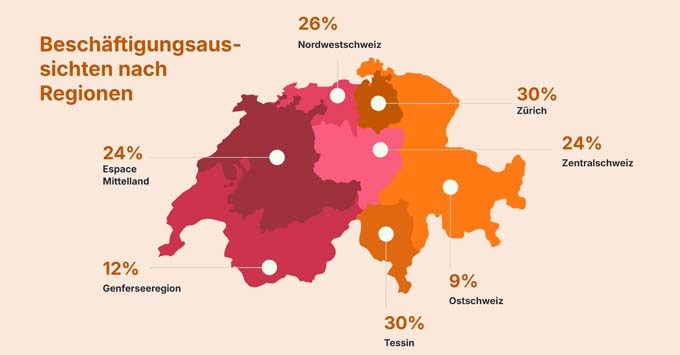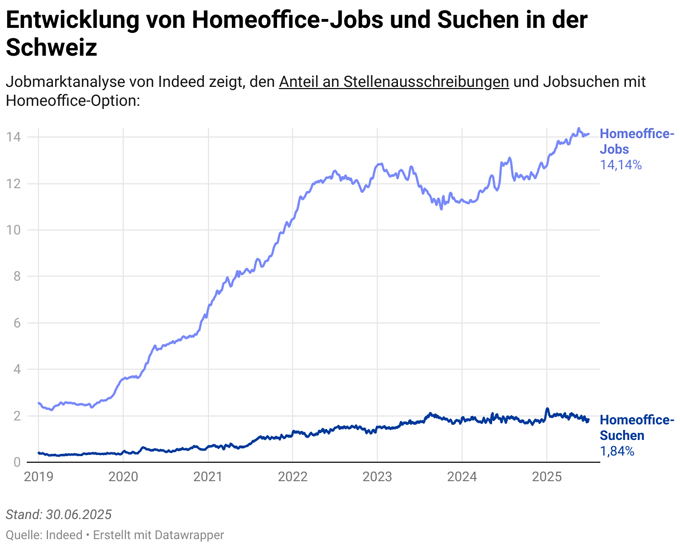Recruitment plans: employers want to hire fewer staff
Swiss employers are cautious about their hiring plans for the third quarter of 2025. The net employment outlook (NEO) has fallen by ten percentage points compared to the same period last year.

Swiss employers report a net employment outlook (NEO) of 24 percentage points for the third quarter of 2025, which corresponds to a decrease of two percentage points compared to the previous quarter and ten percentage points compared to the previous year. Despite the global economic challenges, only 14 % of the companies surveyed expect to reduce their workforce (Q2: 12 %). While 38 % of Swiss companies are still planning to increase their headcount (unchanged compared to Q2), 44 % expect to maintain their headcount (42 % in Q2) and 4 % are uncertain. Overall, the employment forecast for Switzerland remains in the top half of countries in Europe, the Middle East and Africa (EMEA) and exceeds the regional average of 19 % by 5 percentage points as well as neighboring countries (Germany: 20 %, France and Italy: 16 %, Austria: 12 %).
"Hiring prospects in Switzerland are trending downwards as employers face complex workforce changes that are transforming the way they operate," says Eric Jeannerod, Country Manager of ManpowerGroup Switzerland. "Faced with an ageing workforce, global trade volatility and rapid technological advances, companies are increasingly investing in automation to remain competitive and adopting a cautious talent acquisition strategy."
Net employment outlook by sector and region
In the current situation, only companies from the communication services (29 %), consumer goods and services (21 %) and information technology (33 %) sectors reported an improvement in their hiring intentions compared to the previous quarter.
Among the seven Swiss regions, Ticino and Zurich lead the ranking with a NEO of 30 %. Despite a decline of 8 percentage points compared to the previous quarter, the outlook for Ticino is 45 percentage points higher than in the third quarter of 2024. By contrast, the net employment outlook for the Zurich region has fallen by five percentage points compared to the previous quarter and by 18 percentage points compared to the previous year.
Managing changes in the workforce
The Swiss labour market is undergoing a profound transformation shaped by demographic changes, global economic pressures and increasing digitalization. An ageing workforce is changing the priorities of HR departments across the country. More than six in ten organizations (63 %) say that retirement is having a moderate to significant impact on their talent strategies. This trend is particularly pronounced in medium to large companies and in industries such as communications services, healthcare and life sciences, industrials and materials, and transportation and logistics.
Companies drive automation forward
Automation is becoming a cornerstone of HR strategy. Over half of Swiss companies (51 %) plan to increase their investment in automation of tasks and processes either significantly or slightly over the next 12 months in order to streamline their operations and counteract labor shortages. Meanwhile, 24 % expect to maintain current levels of automation and 20 % expect to decrease.
IT and data occupations are at the forefront of this, with 38 % of employers expecting significant changes and a further 38 % expecting moderate shifts, driven by advances in AI and data analytics. This is closely followed by operations and logistics and manufacturing and production, where 33 % of employers expect significant changes and 38 to 40 % expect moderate impacts as automation optimizes supply chains and production processes.
Uncertainty in global trade is another critical factor affecting the Swiss labor market: at the time of the survey (April 2025), 62 % of employers stated that trade-related fluctuations were already having a moderate to significant impact on their hiring decisions.
Source: www.manpowergroup.com









